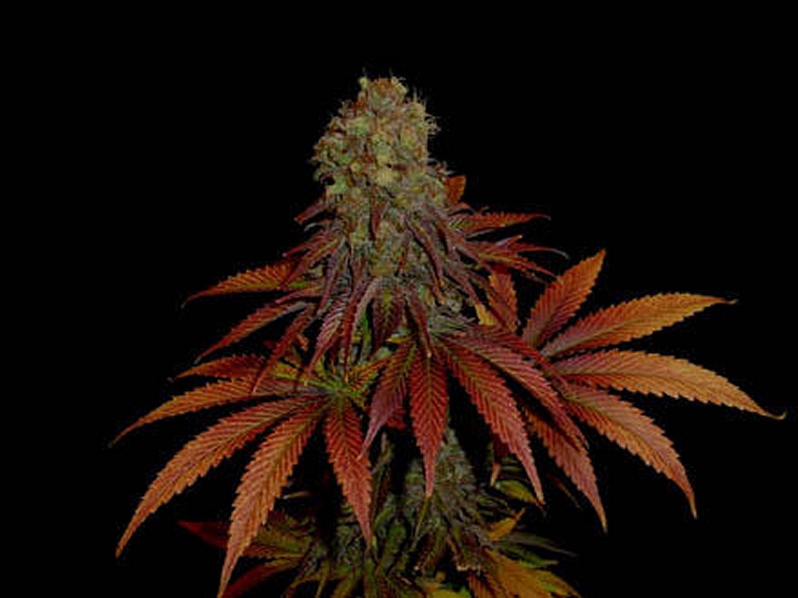
CLASSIFICATION OF CANNABIS is disputed by botanists. They disagree about the family to which it belongs and also about the number of species. The plant is sometimes placed in the fig or mulberry family (Moraceae) or the nettle family (Urticaceae), but it is now usually separated, together with the hop plant (Humulus), into a distinct family: Cannabaceae.
It has been widely thought that there is one species, Cannabis sativa, which, partly as a result of selection by man, has developed many "races" or "varieties," for better fiber, for more oil content, or for stronger narcotic content. Selection for narcotic activity has been especially notable in such areas as India, where intoxicating properties have had religious significance.. Environment also has probably influenced this biologically changeable species, especially for fiber excellence and narcotic activity. Current research indicates that there may be other species: C. indica and C. ruderalis. All Cannabis is native to central Asia
THE MEDICINAL VALUE OF CANNABIS has been known for centuries. Its long history of use in folk medicine is significant, and it has been included more recently in Western pharmacopoeias. It was listed in the United Shtes Pharmacopoeia until the 1930's as valuable, especially in the treatment of hysteria. The progress made in modern research encourages the belief that so prolific a chemical factory as Cannabis may indeed offer potential for new medicines. THE CHEMISTRY OF CANNABIS is complex. Many organic compounds have been isolated, some with narcotic properties and others without. A fresh plant yields mainly cannabidiolic acids, precursors of the tetrahydrocannabinols and related constituents, such as cannabinol, cannabidiol, tetrahydrocannabinol-carboxylic acid, stereoisomers of tetrahydroconnabinol, and cannabichromene.
It has been demonstrated recently that the main effects are attributable to delta -1- tetrahydrocannobinol. The tetrahydrocannabinols, which form an oily mixture of several isomers, are non-nitrogenous organic compounds derived from terpenes . They are not alkaloids, although traces of alkaloids have been reported in the plant.
Until recently, little was known about the effects of pure tetrahydrocannabinol on man. Controlled studies are basic to any progress. These are now possible with the recent synthesis of the compound, a major advance in studying the mechanism of physiological activity of this intoxicant. Because the crude cannabis preparations normally used as a narcotic vary greatly in their chemical composition, any correlations of their biological activity would be relatively meaningless

تفاوت اصلی بین گرس Sativa و Indica در اندازه برگ های آنهاست .
برگ های Sativa کوچکتر و نازکتر از برگ های Indica می باشد.
Indica
بوته کوتاه Indica معمولاً بین 6 فوت تا حداکثر 8 فوت رشد می کنند. برگ های آن کوتاه و گسترده هستند و کاملاً سبزند و با رسیدن به بلوغ برگ های آن شروع به تغییر رنگ می کند و به رنگ بنفش و بنفش تیره در می آیند. معمولاً از اوایل ماه سپتامبر ( شهریور ) شروع به جوانه زدن می کنند .
جوانه های ماری جوانا در رنگ از سبز تیره تا بنفش متفاوت است ، درست مثل ماری جواناهای دیگر . این نوع از ماری جوانا در شرایط آب و هوایی سرد به بلوغ می رسند . جوانه های Indica دارای بوی تند و دود غلیظ می باشد که باعث سرفه های زیاد می شود. بهترین نوع Indica برای آرامش بخشیدن و استفاده از حس و احساس طبیعت است و اجازه به فکر کردن یا تجزیه تحلیل تجربه منجر نمی شود .
Indica باعث کسب تجربه های جدید می شود ، گه گاه باعث سنگین شدن گردن می شود که در اصطلاح به آن Sleep Outs میگویند. Indica در افغانستان ، پاکستان ، هند و مناطق اطراف این کشورها ( ایران ) برداشت می شود . تمام نوع های آن بین 25 تا 35 نوع بستگی به نوع آب و هوای محل رشد آن دارد.
در انگلستان ، اکثریت قریب به اتفاق ماری جواناها از پس زمینه های Indica می باشند. ماریجوانا Indica حاوی مقادیر بالایی CBD وTHC است که باعث ایجاد خواب آلودگی می شود.
Indica High :
بالاترین نقاط indica هستند که اغلب می توان به عنوان وزوز بدن خوشایند توصیف کرد. Indica ها بزرگ برای تمدد اعصاب ، تسکین استرس ، و احساس کلی آرام و بی سر و صدایی و indica ماری جوانا نیز بسیار موثر برای تسکین درد کلی بدن ، و اغلب در درمان بی خوابی استفاده می شود.
بالاترین نقاط indica هستند که اغلب می توان به عنوان وزوز بدن خوشایند توصیف کرد. Indica ها بزرگ برای تمدد اعصاب ، تسکین استرس ، و احساس کلی آرام و بی سر و صدایی و indica ماری جوانا نیز بسیار موثر برای تسکین درد کلی بدن ، و اغلب در درمان بی خوابی استفاده می شود.
Indica خالص برای تمرکز و لذت بردن از تجربیات دود پیشنهاد میشود.
Sativa
اینگونه از ماریجوانا از 6 فوت تا حداکثر 25 فوت رشد می کنند . برگ اینگونه دراز و نازک و به رنگ سبز روشن است . در نوع استوایی اینگونه به دلیل وجود کلروفیل در زمان بلوغ به رنگ زرد در می آیند و در نوع معتدل به رنگ سبز تیره و از 4 فوت به پایین آن تا ساقه به رنگ زرد در می آید و شکل آن به صورت درخت مخروطی شکل است.
جوانه های اینگونه دراز و نازک که گاهی طول هر شاخه آن به 3 فوت یا بیشتر میرسد و به مراتب از نوع Indica کمتر جوانه میزند.عنچه گل ممکن است در آب و هوای خنک به رنگ بنفش و در یک محیط گرم تر نارنجی تیره یا حتی قرمز روشن درآید که بطور قابل توجهی متفاوت است .
در ایالت های غرب و میانه اینگونه در در ماه اوت و سپتامبر به بلوغ میرسد ولی دارای Thc کمی است در حالیکه در مناطق استوایی از ماه نوامبر تا ژانویه به بلوغ میرسد . جوانه های ماریجوانا در نور کم بسیار لاغر و نحیف اما در نور زیاد اغلب بسیار قویند.
جوانه هایSativa دارای بوی شیرین و معطر و دود آنها معمولاً صاف است و باعث ایجاده سرفه نمی شود.
Sativa در سراسر جهان یافت میشود. Sativa سرعت مغز را بالا می برد ، باعث ایجاد انرژی می شود به طوری که هرکاری را می خواهید با سرعت انجام دهید.
اینگونه زیر نور مصنوعی سریعتر بالغ می شود و وزن و THC آن بیشتر و برای فروش سود بیشتری دارد .
Sativa High :
sativa قوی اغلب به عنوان نشاط بخشی و پرانرژی توصیف می شود. اثر ماری جوانا Sativa عمدتا مغزیی به طوری که احساس خوش بینی و خوب بودن ، و همچنین فراهم آوردن معیار خوبی برای تسکین درد است. Sativa دارای THC خالص بالایی است که کاملا توهم زاست.
Sativa بهترین انتخاب برای مصرف روزانه است.

این گیاه که معمولا بطور خودرو در مناطق گرمسیری می روید دارای سه گونه اصلی Sativa و Indica و Ruderalis است. فراورده های این گیاه در صنعت برای تولید کاغذ و الیاف و روغن و در پزشکی برای استفاده دارویی و برای منظور های روحانی، معنوی و همچنین کاربردهای تفریحی استفاده می شود.
ترکیبات موثره شاهدانه، کانابینوئید ها نامیده می شوند. انواع گوناگونی از کانابینوئید ها شامل تترا هیدرو کانابینول، کانابینول، کانابیدیول، اسید کانابینولیدیک، کانابیگرول و کانبیکرومن توسط گیاه سنتز می شوند. تترا هیدرو کانابینول دلتا-9 (Δ-9 THC ) بعنوان مسئول بیشتر آثار روانگردانی شاهدانه شناخته می شود که توسط گیرنده های کانابینوئیدی در مغز جذب می شود. گونه Sativa بیشتر دارای اثر روانی و محرک و گونه Indica بیشتر دارای اثر جسمی و آرامبخش است

METHODS OF USING CANNABIS vary. In the New World, marihuana (maconha in Brazil) is smoked—the dried, crushed flowering tips or leaves, often mixed with tobacco in cigarettes, or "reefers." Hasheesh, the resin from the female plant, is eaten or smoked, often in water pipes, by millions in Moslem countries of northern Africa and western Asia. In Afghanistan and Pakistan, the resin is commonly smoked. Asiatic Indians regularly employ three preparations narcotically: bhang consists of plants thst are gathered green, dried, and made into a drink with water or milk or into a candy (majun) with sugar and spices; charas, normally smoked or eaten with spices, is pure resin; ganjah, usually smoked with tobacco, consists of resin-rich dried tops from the female plant. Many of these unusually potent preparations may be derived from C. indica.
NARCOTIC USE OF CANNABIS has grown in popularity in the past 40 years as the plant has spread to nearly all parts of the globe. The narcotic use of cannabis in the United States dates from the 1920's and seems to have started in New Orleans and vicinity. Increase in the plant's use as an inebriant in Western countries, especially in urban centers, has led to major problems and dilemmas for European and American authorities. There is a sharp division of opinion as to whether the widespread narcotic use of cannabis is a vice that must be stamped out or is an innocuous habit that should be permitted legally. The subject is debated hotly, usually with limited knowledge. We do not yet have the medical, social, legal, and moral information on which to base a sound judgment. As one writer has said, the marihuana problem needs "more light and less heat." Controlled, scientifically valid experiments with cannabis, involving large numbers of individuals, have not as yet been madeEFFECTS OF CANNABIS, even more than of other hallucinogens, are highly variable from person to person and from one plant strain to another. This variability comes mainly from the unstable character of some of the constituents. Over a period of time, for example, the inactive cannabidiolic acid converts to active tetrahydrocannabinols and eventually to inactive cannabinol, such chemical changes usually taking place more rapidly in tropical than in cooler climates. Material from plants of different ages may thus vary in narcotic effect.
The principal narcotic effect is euphoria. The plant is sometimes not classified as hallucinogenic, and it is true that its characteristics are not typically psychotomimetic. Everything from a mild sense of ease and well-being to fantastic dreams and visual and auditory hallucinations are reported. Beautiful sights, wonderful music, and aberrations of sound often entrance the mind; bizarre adventures to fill a century take place in a matter of minutes.
Soon after taking the drug, a subject may find himself in a dreamy state of altered consciousness. Normal thought is interrupted, and ideas are sometimes plentiful though confused. A feeling of exaltation and inner joy may alternate, even dangerously, with feelings of depression, moodiness, uncontrollable fear of death, and panic. Perception of time is almost invariably altered. An exaggeration of sound, out of all relation to the real force of the sound emitted, may be accompanied by a curiously hypnotic sense of rhythm. Although the occasional vivid visual hallucinations may have sexual coloring, the often-reported aphrodisiac properties of the drug have not been substantiated.
NARCOTIC USE OF CANNABIS has grown in popularity in the past 40 years as the plant has spread to nearly all parts of the globe. The narcotic use of cannabis in the United States dates from the 1920's and seems to have started in New Orleans and vicinity. Increase in the plant's use as an inebriant in Western countries, especially in urban centers, has led to major problems and dilemmas for European and American authorities. There is a sharp division of opinion as to whether the widespread narcotic use of cannabis is a vice that must be stamped out or is an innocuous habit that should be permitted legally. The subject is debated hotly, usually with limited knowledge. We do not yet have the medical, social, legal, and moral information on which to base a sound judgment. As one writer has said, the marihuana problem needs "more light and less heat." Controlled, scientifically valid experiments with cannabis, involving large numbers of individuals, have not as yet been madeEFFECTS OF CANNABIS, even more than of other hallucinogens, are highly variable from person to person and from one plant strain to another. This variability comes mainly from the unstable character of some of the constituents. Over a period of time, for example, the inactive cannabidiolic acid converts to active tetrahydrocannabinols and eventually to inactive cannabinol, such chemical changes usually taking place more rapidly in tropical than in cooler climates. Material from plants of different ages may thus vary in narcotic effect.
The principal narcotic effect is euphoria. The plant is sometimes not classified as hallucinogenic, and it is true that its characteristics are not typically psychotomimetic. Everything from a mild sense of ease and well-being to fantastic dreams and visual and auditory hallucinations are reported. Beautiful sights, wonderful music, and aberrations of sound often entrance the mind; bizarre adventures to fill a century take place in a matter of minutes.
Soon after taking the drug, a subject may find himself in a dreamy state of altered consciousness. Normal thought is interrupted, and ideas are sometimes plentiful though confused. A feeling of exaltation and inner joy may alternate, even dangerously, with feelings of depression, moodiness, uncontrollable fear of death, and panic. Perception of time is almost invariably altered. An exaggeration of sound, out of all relation to the real force of the sound emitted, may be accompanied by a curiously hypnotic sense of rhythm. Although the occasional vivid visual hallucinations may have sexual coloring, the often-reported aphrodisiac properties of the drug have not been substantiated.
In many parts of Asia the use of cannabis preparations is both socially and legally acceptable. In predominantly Moslem countries, Cannabis is usually smoked in water pipes sometimes called hookahs. The illustration shows an Afghani using one of the many kinds of water pipes seen in Asia.

شاهدانه
شاهدانه (به انگلیسی Cannabis) گیاهی یک ساله با برگهای قطرهای است. میوه این گیاه ریز و روغنی بوده و خاصیت آرامش بخش دارد که از آن برای درمان تخدیر نیز استفاده میشود. در فرهنگ لاتین به گل شاهدانه ماری جوانا گفته میشود. بهترین ماری جوانای دنیا در کشور جامائیکا میروید که سمبل این کشور برگ شاهدانهاست.
گیاهی شبیه به گزنه که بلندیش تا دو متر میرسد برگهایش دراز است و دانههایی به اندازه فندق دارد که روغنی و بدبوست و از آن روغنی میگیرند که به مصرف تهیه صابون میرسد. از سر شاخههای گلدار آن بنگ و چرس گرفته میشود.
بر طبق بیانات مورخین، شاهدانه از اولین گیاهانی بوده که توسط بشر کشت شده است و استفاده از برگ شاهدانه به عنوان مخدر به بیش از ۳۰۰۰ قبل از میلاد میرسد. بر طبق گزارش سازمان ملل، سالانه حدود ۱۶۴ میلیون نفر از شاهدانه به عنوان مخدر استفاده میکنند و این در حالی است که قریب به ۲۳ میلیون نفر آنرا روزانه مصرف میکنند.
استعمال شاهدانه
گیاه شاهدانه نر دارای خاصیت مخدر ضعیف بوده و گیاه ماده یکی از پر طرفدار ترین مخدرهای دنیاست.گیاه مؤنث شاهدانه دارای چندین گل است. به این گلها ماری جوانا گفته میشود که پس از چیدن از گیاه و خشک شدن باید آنرا میان انگشتان گرفت و با فشار دادن به صورت ریز شده در آورد. داخل تخمدان، دانههای سیاه رنگی است که در حقیقت همان شاهدانهای است که به عنوان آجیل در ایران مصرف میشود و طعم مطبوعی دارد. گلبرگهای ریز شده را همانند توتون سیگار در یک کاغذ میپیچند و اکثرا بدون فیلتر آنرا میکشند. اگر برای مصرف ماری جوانا دانهای شاهدانه را جدا نکنند، هنگام کشیدن آن تولید صدای تق تق میکند و باعث چرب شدن کاغذ میشود. دود ناشی از کشیدن ماری جوانا بسیار زیاد و غلیط است.
تاثیرات
- احساس سر خوشی غیر طبیعی
- خنده آور
- سرخی قابل توجه چشمها
- خشکی دهان
- افزایش اشتها و عطش فراوان
- انبساط عضلات
- افزایش ضربان قلب
- در نهایت خواب آلودگی و احساس آرامش

HISTORY OF CANNABIS USE dates to ancient times. Hemp fabrics from the late 8th century B.C. have been found in Turkey. Specimens have turned up in an Egyptian site nearly 4,000 years of age. In ancient Thebes, the plant was made into a drink with opium-like effects. The Scythians, who threw cannabis seeds and leaves on hot stones in steam baths to produce an intoxicating smoke, grew the plant along the Volga 3,000 years ago.
Chinese tradition puts the use of the plant back 4,800 years. Indian medical writing, compiled before 1000 B.C., reports therapeutic uses of cannabis. That the early Hindus appreciated its intoxicating properties is attested by such names as "heavenly guide" and soother of grief. " The Chinese referred to cannabis as "liberator of sin" and "delight giver." The Greek physician Galen wrote, about A.D. 160, that general use of hemp in cakes produced narcotic effects. In 13th century Asia Minor, organized murderers, rewarded with hasheesh, were known as hashishins from which may come the term assassin in European languages.
Hemp as a source of fiber was introduced by the Pilgrims to New England and by the Spanish and Portuguese to their colonies in the New World
1 comment:
فلونیای فارسی
Post a Comment